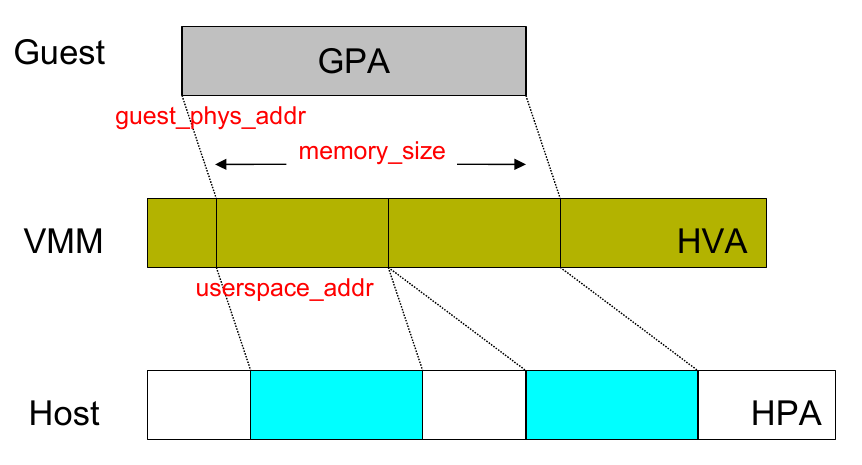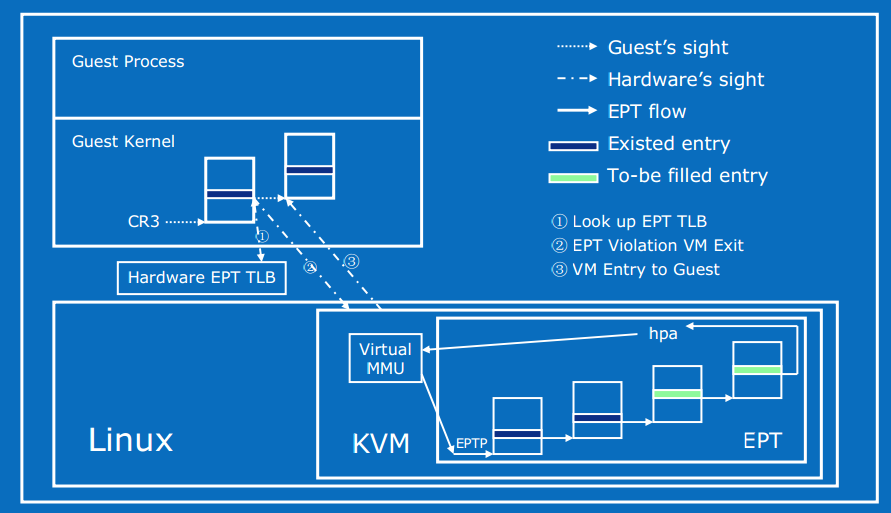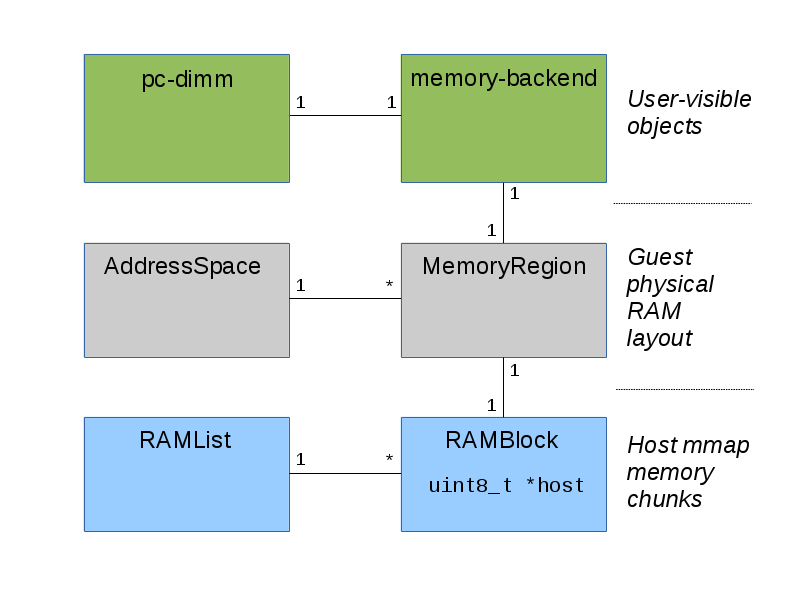QEMU-KVM内存虚拟化
qemu-kvm的内存虚拟化方案,是由qemu和kvm共同完成的,所以可以分为两部分。qemu完成内存的申请,kvm实现内存的管理。内部实现及其复杂,本篇博客尽量整理搜集相关资料,目的是分析出如何将
GPA 转换成 HVA 。
词汇约定
| 缩写 | 意义 |
|---|---|
| VA | Virtual Address, 虚拟地址 |
| PA | Physical Address, 物理地址 |
| PML4 | Page Map Level 4 |
| PDPT | Page Directory Pointer Table |
| PD | Page Directory |
| PT | Page Table |
| PGD | Page Global Directory |
| PUD | Page Upper Directory |
| PMD | Page Middle Directory |
| GVA | Guest Virtual Address |
| GPA | Guest Physical Address |
| HVA | Host Virtual Address |
| HPA | Host Physical Address |
| GFN | Guest Frame Number,虚拟机的页框号 |
| PFN | Host Page Frame Number,宿主机的页框号 |
| SPT | Shadow Page Table,影子页表 |
页表
64位CPU上支持 48 位的虚拟地址寻址空间,和 52
位的物理地址寻址空间。Linux采用4级页表机制将虚拟地址(VA)转换成物理地址(PA),先从页表的
基地址寄存器 (CR3)
中读取页表的起始地址,然后加上页号得到对应页的页表项,从中取出页的物理地址,再加上偏移量得到
PA。
分级的查询页表过程为:
Page Map Level 4(PML4) =>
Page Directory Pointer Table(PDPT) =>
Page Directory(PD) =>
Page Table(PT)在某些地方被称为:
Page Global Directory(PGD) =>
Page Upper Directory(PUD) =>
Page Middle Directory(PMD) =>
Page Table(PT)QEMU内存虚拟化
QEMU 利用 mmap
系统调用,在QEMU进程的虚拟地址空间中申请连续的大小的空间,作为 Guest
的物理内存,即 内存的申请是在用户空间完成的。
通过 KVM 提供的 API,QEMU 将 Guest 内存的地址信息传递并注册到 KVM
中维护,即内存的管理是由内核空间的 KVM 实现的。
在这样的架构下,内存地址访问有四层映射:
GVA -> GPA -> HVA -> HPA
GVA - GPA 的映射由 guest OS 负责维护,而 HVA - HPA 由 host OS
负责维护。 而内存虚拟化的关键是 GPA -> HVA
的映射。

为了提高从GVA到HPA的转换效率,KVM常用的实现有
SPT(Shadow Page Table) 和 EPT/NPT
,前者通过软件维护影子页表直接将GVA转换成HPA,省略中间的映射;后者通过硬件特性实现二级映射(two dimentional paging),将GPA转换成HPA。
影子页表(SPT)
影子页表是在KVM维护记录的,可以直接将 GVA 转换为
HPA,影子页表可被载入物理 MMU 为客户机直接寻址使用,
减少了地址转换带来的开销。
在guest中的虚拟内存管理中,通过查询CR3寄存器完成完成
GVA->GPA。
CR3保存了Guest的页表基址地址,然后载入MMU中进行地址转换。
在加入了SPT技术后,当Guest访问CR3时,KVM捕获此访问操作,即
EXIT_REASON_CR_ACCESS,之后KVM载入特殊的CR3和影子页表。之后访存操作和传统方式一样,只需要经过一层影子页表就可以访问到物理地址。
而且,在 TLB 和 CPU
缓存上缓存的是来自影子页表中GVA和HPA之间的映射,也因此提高了缓存的效率。
影子页表异常处理机制
在通过影子页表进行寻址的过程中,有两种原因会引起影子页表的缺页异常,一种是由客户机本身所引起的缺页异常,
具体来说就是客户机所访问的客户机页表项存在位 (Present Bit) 为
0,或者写一个只读的客户机物理页,再者所访问的客户机虚拟地址无效等。
另一种异常是由客户机页表和影子页表不一致引起的异常。
当Guest对页表修改时会触发Page Fault,VM-EXIT 到 KVM,之后 KVM 会对
GVA 对应的页表项进行访问权限检查,结合错误码进行判断与处理。
如果该异常是由客户机本身引起的,KVM
直接把该异常交由客户机的缺页异常处理机制来进行处理。
如果该异常是由客户机页表和影子页表不一致引起的,KVM
则根据客户机页表同步影子页表。
为此,KVM 要建立起相应的影子页表数据结构,根据 Guest 页表和 mmap
映射找到 GPA 到 HVA
的映射关系,在SPT中填充GVA->HPA的页表项,还要根据Guest页表项的访问权限修改SPT对应页表项的访问权限。
哈希链表
为了快速检索Guest页表对应的影子页表,KVM为每个客户机维护了一个hash表来进行客户机页表到影子页表之间的映射。
对于每一个Guest来说,其页目录和页表都有唯一的GPA,通过页目录/页表的GPA就可以在哈希链表中快速地找到对应的影子页目录/页表。
当Guest切换进程时,Guest会把待切换进程的页表基址载入 CR3,而 KVM
将会截获这一特权指令。KVM在哈希表中找到与此页表基址对应的影子页表基址,载入Guest
CR3,使Guest在恢复运行时 CR3 实际指向的是新切换进程对应的影子页表。
缺点:
影子页表的引入也意味着 KVM
需要为每个客户机的每个进程的页表都要维护一套相应的影子页表,这会带来较大内存上的额外开销。
同时影子页表的建立是很耗时的,如果 Guest
的进程过多,将导致影子页表频繁切换。
此外,客户机页表和和影子页表的同步也比较复杂。
扩展页表(EPT/NPT)
Intel 的 EPT(Extent Page Table)技术和 AMD 的 NPT(Nest Page Table)技术都对内存虚拟化提供了硬件支持。 这两种技术原理类似,都是在硬件层面上实现GVA到HPA之间的转换。 下面就以 EPT 为例分析一下 KVM 基于硬件辅助的内存虚拟化实现。

EPT 技术采用了在两级页表结构,即原有Guest
OS页表对GVA->GPA映射的基础上,又引入了 EPT
页表来实现GPA->HPA的另一次映射,这两次地址映射都是由硬件自动完成。
Guest运行时,客户机页表被载入 CR3,实现 GVA 到 GPA 的转换。
而 EPT 页表被载入专门的 EPT 页表指针寄存器 EPTP。EPT 中维护着 GPA 到 HPA
的映射,而 EPTP 负责指向 EPT。 EPT
页表对地址的映射机理与Guest页表对地址的映射机理相同。
在GPA到HPA转换的过程中,由于缺页、写权限不足等原因也会导致VM exit,产生 EPT 异常。 对于 EPT Page Fault,KVM 首先根据引起异常的GPA映射到对应的HVA,然后为此虚拟地址分配新的物理页,最后 KVM 再更新 EPT 页表,建立起引起异常的GPA到HPA之间的映射。对 EPT 写权限引起的异常,KVM 则通过更新相应的 EPT 页表来解决。
优势:
Guest 的缺页在 Guest OS 内部处理,不会 VM-EXIT 到 KVM 中。 地址转化基本由硬件(MMU)查页表来完成,大大提升了效率。 KVM 只需为每个客户机维护一套 EPT 页表,也大大减少了内存的额外开销。
内存数据结构
QEMU虚拟内存最重要的几个数据结构 AddressSpace 、
MemoryRegion 、 MemoryRegionSection 、
RAMBlock 、 kvm_userspace_memory_region 。

PCDIMMDevice
PC DIMM内存设备模拟,通过 QOM(qemu object model)
定义的虚拟内存条。可通过 QEMU 命令行进行管理。通过增加/移除该对象实现 VM
中内存的热插拔。 1
2
3
4
5
6
7
8
9
10
11
12
13
14
15
16
17
18
19
20/include/hw/mem/pc-dimm.h
/**
* PCDIMMDevice:
* @addr: starting guest physical address, where @PCDIMMDevice is mapped.
* Default value: 0, means that address is auto-allocated.
* @node: numa node to which @PCDIMMDevice is attached.
* @slot: slot number into which @PCDIMMDevice is plugged in.
* Default value: -1, means that slot is auto-allocated.
* @hostmem: host memory backend providing memory for @PCDIMMDevice
*/
typedef struct PCDIMMDevice {
/* private */
DeviceState parent_obj;
/* public */
uint64_t addr; // 映射到的起始 GPA
uint32_t node; // 映射到的 numa 节点
int32_t slot; // 插入的内存槽编号,默认为 -1,表示自动分配
HostMemoryBackend *hostmem; // 对应的 backend
} PCDIMMDevice;
HostMemoryBackend
通过 QOM 定义的一段 Host 内存,为虚拟内存条提供内存。可通过 QMP 或
QEMU 命令行进行管理。 1
2
3
4
5
6
7
8
9
10
11
12
13
14
15
16
17
18
19
20/**
* @HostMemoryBackend
*
* @parent: opaque parent object container
* @size: amount of memory backend provides
* @mr: MemoryRegion representing host memory belonging to backend
*/
struct HostMemoryBackend {
/* private */
Object parent;
/* protected */
uint64_t size; // 提供内存大小
bool merge, dump;
bool prealloc, force_prealloc, is_mapped, share;
DECLARE_BITMAP(host_nodes, MAX_NODES + 1);
HostMemPolicy policy;
MemoryRegion mr; // 拥有的 MemoryRegion
};
MemoryRegion
1 | struct MemoryRegion { |
MemoryRegion 是树状结构,有多种类型,可以表示一段
ram ,rom ,MMIO 。
alias 表示一个 MemoryRegion 的一部分区域。
MemoryRegion
也可以表示一个container,这就表示它只是其他若干个
MemoryRegion 的容器。在 MemoryRegion
中,ram_block表示的是分配的实际内存。
address_space_memory 的 root 为
system_memory ,address_space_io 的
root 为 system_io 。 1
2static MemoryRegion *system_memory;
static MemoryRegion *system_io;
AddressSpace
1 | /include/exec/memory.h |
AddressSpace
表示的CPU/设备看到的地址空间,比如内存地址空间
AddressSpace address_space_memory; 和IO地址空间
AddressSpace address_space_io; 。 每个
AddressSpace 一般包含一系列 MemoryRegion :
AddressSpace 的 root 指向根级 MemoryRegion
,该 MemoryRegion 有可能有自己的若干个
subregion ,于是形成树状结构。 所有的
AddressSpace 通过结构中的 address_spaces_link
连接成链表,表头保存在全局的 AddressSpace 结构中。
RAMBlock
1 | /include/exec/ram_addr.h |
在这里,host
指向了动态分配的内存,用于表示实际的虚拟机物理内存,而
offset 表示了这块内存在虚拟机物理内存中的偏移。每一个
ram_block 还会被连接到全局的 ram_list
链表上。
AddressSpace 的
root及其子树形成了一个虚拟机的物理地址,但是在往kvm进行设置的时候,需要将其转换为一个平坦的地址模型,也就是从0开始的。这个就用FlatView
表示,一个 AddressSpace 对应一个 FlatView
。
1 | /* Flattened global view of current active memory hierarchy. Kept in sorted |
RAMList
ram_list 是一个全局变量,以链表的形式维护了所有的
RAMBlock 。
1 | include/exec/ramlist.h |
MemoryRegionSection
在内存虚拟化中,还有一个重要的结构是 MemoryRegionSection
,这个结构通过函数 section_from_flat_range 可由
FlatRange 转换过来。 1
2
3
4
5
6
7
8
9
10
11
12
13
14
15
16
17
18
19/**
* MemoryRegionSection: describes a fragment of a #MemoryRegion
*
* @mr: the region, or %NULL if empty
* @fv: the flat view of the address space the region is mapped in
* @offset_within_region: the beginning of the section, relative to @mr's start
* @size: the size of the section; will not exceed @mr's boundaries
* @offset_within_address_space: the address of the first byte of the section
* relative to the region's address space
* @readonly: writes to this section are ignored
*/
struct MemoryRegionSection {
MemoryRegion *mr; // 指向所属 MemoryRegion
FlatView *fv;
hwaddr offset_within_region; // 起始地址 (HVA) 在 MemoryRegion 内的偏移量
Int128 size;
hwaddr offset_within_address_space; // 在 AddressSpace 内的偏移量,如果该 AddressSpace 为系统内存,则为 GPA 起始地址
bool readonly;
};